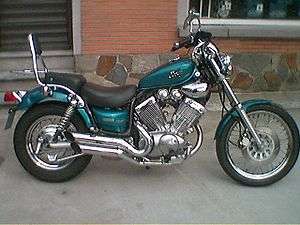Yamaha Virago
 | |
| Manufacturer | Yamaha |
|---|---|
| Class | Cruiser |
| Engine | V-twin |
The Yamaha Virago was Yamaha's first V-twin cruiser motorcycle, and one of the earliest mass-produced motorcycles with a mono-shock rear suspension. Originally sold with a 750 cc (46 cu in) engine in 1981, Yamaha soon added 500 cc (31 cu in) and 900 cc (55 cu in) versions.
The bike was redesigned in 1984, switching from a rear mono-shock to a dual-shock design, and adding a tear-drop shaped gas tank. That year, Harley-Davidson, fearful of the inroads in the US market made by the Virago and other new Japanese cruiser-style motorcycles, pushed for a tariff on imported bikes over 700 cc.[1][2] Yamaha replaced the 750 cc engine with a 699 cc version to avoid the tariff, while the 920 cc engine grew to 1000 cc, and later 1100 cc. In the late 1980s a 250 cc Virago was added. A short production of 125 cc was also manufactured. Yamaha made an XV125, XV250, XV400, XV500, XV535, XV700, XV750, XV920R, XV1000/TR1, and an XV1100, with the XV400SCLX being the rarest.
The larger-displacement Viragos were eventually phased out of production, replaced by the V-Star and Road Star series of motorbikes. The last motorcycle to bear the Virago name was the 2007 Virago 250. For 2008 it was renamed the V-Star 250.
According to Motorcyclist magazine, the early Virago has a design flaw in the starter system. This magazine states that the starter's defect exists in early Virago models made in year 1981, 1982 and 1983.[3]
Models
- Yamaha Virago XV125
- Yamaha Virago XV250
- Yamaha Virago XV400
- Yamaha Virago XV500
- Yamaha Virago XV535
- Yamaha Virago XV700
- Yamaha Virago XV750
- Yamaha Virago XV920
- Yamaha Virago XV1000
- Yamaha Virago XV1100
References
- ↑ Cycle Tariffs Predicted. The Milwaukee Journal. April 1, 1983
- ↑ Reagan Imposes Stiff Tariffs on Large Japanese Motorcycles. Associated Press. Bangor Daily News. April 2-3, 1983.
- ↑ Minton, Joe (January 1988), "Vitalizing the Virago", Motorcyclist: 68, retrieved 2013-06-08